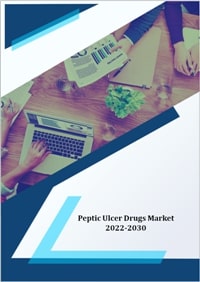
A peptic ulcer is forms of painful sores that develops on the mucosal lining of the stomach, small intestine or lower esophagus. Increase in prevalence of H. Pylori infection, improved diagnostic techniques, easy availability of treatment medication, preferable use of peptic ulcer medication over surgery, increase in rate of smocking and over use of NSAIDs are driving the growth of peptic ulcer drugs market globally.
The report titled “Peptic Ulcer Drugs Market - Growth, Future Prospects and Competitive Analysis, 2023–2030” offers strategic insights into the overall peptic ulcer drugs market along with the market size and estimates for the duration 2020 to 2030.
Along with quantitative information, qualitative information sets and assessment tools are provided in this study for better analysis of the overall market scenario and future prospects. Information such as market inclination insights and drivers, challenges and opportunities assists the readers for understanding the ongoing trends in the global peptic ulcer drugs market. In depth analysis of pipeline molecule for key products in peptic ulcer treatment, global epidemiology data for peptic ulcer have been included in report. Tools such as market positioning of key players and attractive investment proposition provide the readers with insights on the competitive scenario of the global peptic ulcer drugs market. This report concludes with company profiles section that highlights major information about the key players engaged in global peptic ulcer drugs market. In-depth competitive environment analysis and historical years (2020) market size data are also provided in the report.
Peptic ulcers are forms of painful sores that develops on the mucosal lining of the stomach, small intestine or lower esophagus. Some factors such as increase in incidence of H. pylori infections, change in lifestyles such as stress and diet pattern, increasing smoking rate, overuse of NSAIDs such as Naproxen, Ibuprofen, Aspirin, and Ketoprofen, improve diagnostics techniques and preferable used of medication over the surgeries are driving the growth of peptic ulcer drugs market globally. For the purpose of the study, the peptic ulcer drugs market is segmented on the basis of drug class such as antibiotics, proton pump inhibitors (PPIs), H2 receptor antagonists, gastric mucosal protective drugs, antacids and prostaglandin agonists. It is studied that, in the base year 2016, PPIs were major revenue generating segment because these drugs are preferably prescribed in market for treatment of peptic ulcers caused by H. pylori bacterial infection and NSAIDs. PPIs reduce the amount of acid by blocking the action of the parts of cells that produce acid and prevent further damage.
It is studied that, in the base year 2021, North America dominated the peptic ulcer drugs market in terms of revenue and it is anticipated that it will show steady growth during forecast period of 2023-2030. Factors such as large number of affected population, higher cost of treatment medication, improved diagnostic technique and upsurge in funding by the government agencies in healthcare system are driving the growth of peptic ulcer drugs market in North America. According to Centers for Disease Control and Prevention (CDC) peptic ulcer is a common illness that affects more than 6 million population in the United States annually. It is observed that currently, Europe is the second largest revenue generating regional market for peptic ulcer drugs due to higher number of affected population, improved diagnostics technique, high healthcare awareness and overuse of pain medication are driving the market growth in Europe. U.K., Germany and France are major revenue-contributing countries in Europe. It is anticipated that Asia Pacific will show highest growth rate during the forecast period due to populous countries, developing economic condition and improving healthcare infrastructure would contribute the market growth in Asia Pacific during the forecast period.
Historical & Forecast Period
This study report represents analysis of each segment from 2022 to 2032 considering 2023 as the base year. Compounded Annual Growth Rate (CAGR) for each of the respective segments estimated for the forecast period of 2024 to 2032.
The current report comprises of quantitative market estimations for each micro market for every geographical region and qualitative market analysis such as micro and macro environment analysis, market trends, competitive intelligence, segment analysis, porters five force model, top winning strategies, top investment markets, emerging trends and technological analysis, case studies, strategic conclusions and recommendations and other key market insights.
Research Methodology
The complete research study was conducted in three phases, namely: secondary research, primary research, and expert panel review. key data point that enables the estimation of Peptic Ulcer Drugs market are as follows:
Market forecast was performed through proprietary software that analyzes various qualitative and quantitative factors. Growth rate and CAGR were estimated through intensive secondary and primary research. Data triangulation across various data points provides accuracy across various analyzed market segments in the report. Application of both top down and bottom-up approach for validation of market estimation assures logical, methodical and mathematical consistency of the quantitative data.
| ATTRIBUTE | DETAILS |
|---|---|
| Research Period | 2022-2032 |
| Base Year | 2023 |
| Forecast Period | 2024-2032 |
| Historical Year | 2022 |
| Unit | USD Million |
| Segmentation | |
Drug
| |
|
Region Segment (2022-2032; US$ Million)
|
Key questions answered in this report